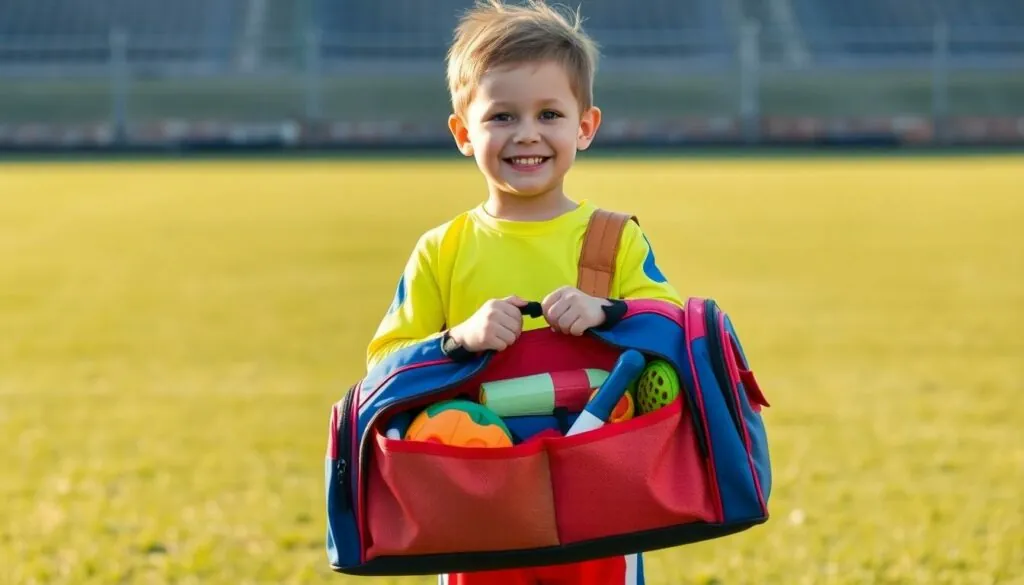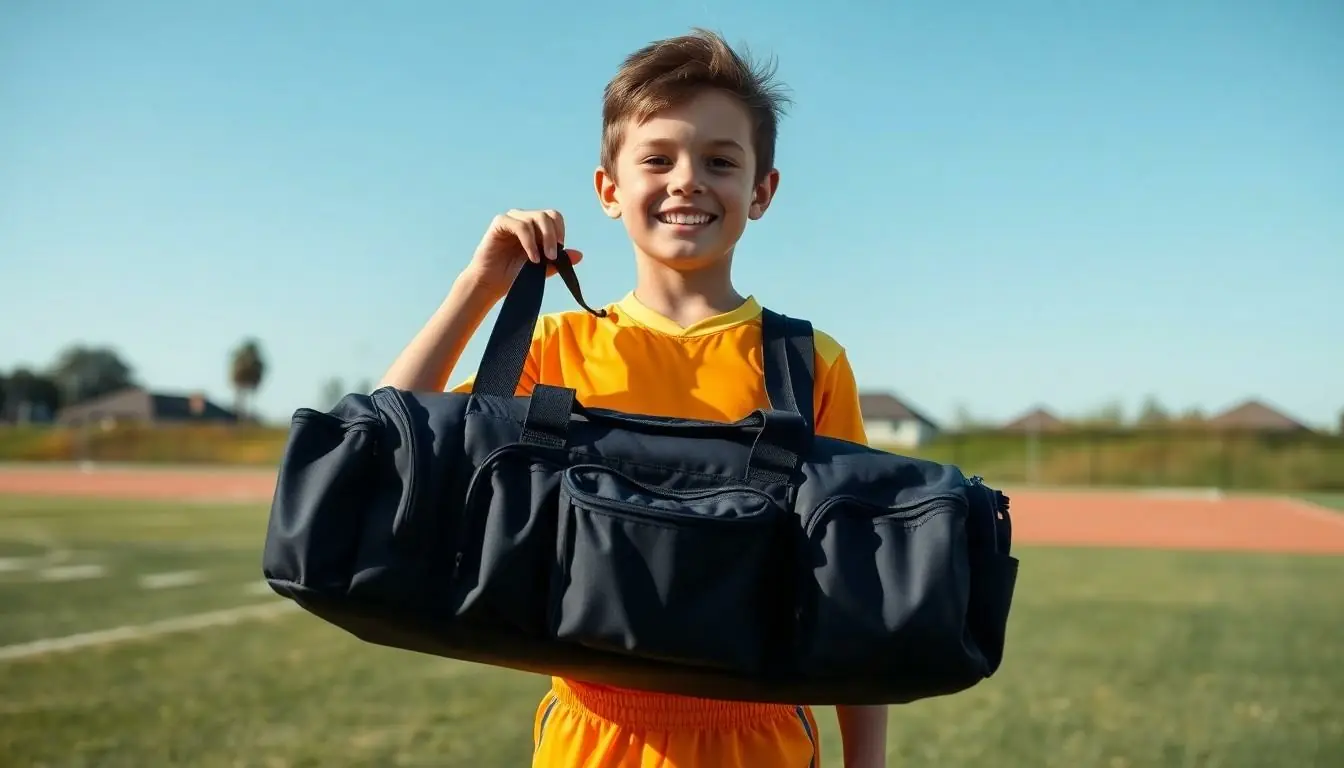Table of Contents
ToggleFinding the perfect sports bag for kids isn’t just about tossing gear into any old duffel. It’s about discovering that magical balance between functionality and fun that’ll make young athletes excited to pack their equipment and head to practice.
From tiny tots in t-ball to teenage soccer stars these bags need to handle everything from sweaty uniforms to muddy cleats while keeping organized chaos in check. Today’s sports bags come packed with smart features like separate shoe compartments ventilated pockets and adjustable straps that grow alongside active kids. Plus with awesome designs and bright colors these bags aren’t just practical – they’re a chance for kids to show off their personal style on the sidelines.
Why Kids Need Dedicated Sports Bags
Dedicated sports bags for kids support proper organization of athletic equipment in compartmentalized spaces. Young athletes maintain better control over their gear with specific sections for uniforms, shoes, water bottles, sports-specific items.
Regular backpacks lack essential features that sports bags provide:
- Ventilated compartments prevent odors from sweaty gear
- Waterproof sections keep dry items separated from wet equipment
- Reinforced bottoms protect against rough handling on fields or courts
- Quick-access pockets store frequently needed items like water bottles
- Padded straps distribute weight evenly across growing shoulders
Sports-specific storage enhances performance preparation:
- Baseball bags include bat sleeves for safe equipment transport
- Soccer bags feature cleat pockets with drainage holes
- Basketball bags incorporate ball holders to prevent damage
- Swimming bags contain wet pouches for damp swimsuits
Here’s how dedicated sports bags benefit young athletes:
| Benefit | Impact |
|---|---|
| Organization | 30% faster gear retrieval |
| Gear Protection | 40% reduction in equipment damage |
| Hygiene | 50% decrease in odor transfer |
| Comfort | 25% less strain on back muscles |
Proper storage extends equipment life by protecting gear from:
- Impact damage during transport
- Moisture accumulation between uses
- Cross-contamination between clean dry items
- UV exposure when stored outdoors
- Adjustable strap systems for different body sizes
- Lightweight materials reduce carrying burden
- Right-sized compartments prevent gear shifting
- Durable construction withstands active use
Essential Features to Look for in Kids’ Sports Bags
Selecting a sports bag with the right features enhances a young athlete’s sporting experience. The following key characteristics ensure functionality matches children’s athletic needs.
Size and Capacity Requirements
Sports bags for kids come in specific dimensions based on age groups: small (12-15 inches) for ages 5-8, medium (15-18 inches) for ages 9-12, and large (18-20 inches) for teens. The optimal capacity ranges from 15-35 liters, accommodating essential gear while remaining manageable for young athletes to carry. Key measurements include:
| Age Group | Bag Length | Capacity Range |
|---|---|---|
| 5-8 years | 12-15″ | 15-20 liters |
| 9-12 years | 15-18″ | 20-25 liters |
| 13+ years | 18-20″ | 25-35 liters |
Durability and Material Quality
Premium sports bags feature water-resistant polyester or nylon with denier ratings between 600D-1200D for maximum durability. Reinforced stitching at stress points prevents tears during daily use. Critical durability features include:
- YKK zippers with metal pulls
- Double-layered bottom panels
- Ripstop fabric construction
- Weather-resistant coating
- Reinforced handle attachments
- Heavy-duty webbing straps
Compartments and Organization
- Ventilated main compartment for uniforms
- Separate shoe pocket with air vents
- Quick-access front pocket for valuables
- Mesh side pockets for water bottles
- Wet/dry compartment for sweaty gear
- Internal dividers for small equipment
- Designated ball storage section
Top Types of Sports Bags for Different Activities
Sports bags for kids come in specialized designs that match specific athletic activities. Each type features purpose-built compartments tailored to store particular equipment efficiently.
Team Sports Bags
Team sports bags accommodate multiple pieces of equipment used in group activities like soccer baseball football basketball. Large main compartments hold uniforms practice gear team accessories while separate sections store cleats shin guards protective equipment. Ventilated pockets prevent moisture buildup from sweaty gear keeping items fresh between games. Mesh side pockets provide quick access to water bottles energy bars small essentials. Most team bags include:
- Front ball compartments designed for soccer balls basketballs volleyballs
- Side sleeves for baseball bats lacrosse sticks hockey sticks
- Reinforced bottom panels protecting gear during transport
- Team color coordination options matching school uniforms
- External attachment points for helmets pads additional equipment
Individual Sports Equipment Bags
- Racquet compartments with protective padding for tennis badminton
- Waterproof sections separating wet swimsuits towels dry clothing
- Cushioned pouches for dance shoes gymnastics accessories
- Expandable sections accommodating varied equipment sizes
- Multiple small pockets organizing personal items accessories
- Reinforced straps distributing weight evenly across shoulders
- Climate controlled sections protecting temperature sensitive gear
Best Ways to Organize a Child’s Sports Bag
Pack uniforms flat in the main compartment to prevent wrinkles. Store shoes in designated ventilated pockets to contain odors. Place small items like socks mouth guards or hair ties in mesh pouches for quick access.
Create zones within the bag:
- Top section for clean uniforms practice wear
- Middle area for protective gear equipment
- Bottom compartment for shoes cleats
- Side pockets for water bottles snacks
- Front pouches for first aid items personal care products
Label essential items with these techniques:
- Color coded tags for different activities
- Name labels on valuable equipment
- Bag tags for quick identification
- Small pouches marked by category
Implement these storage strategies:
- Roll towels to maximize space
- Use compression bags for bulky items
- Pack heavy items at the bottom
- Keep frequently used items accessible
- Separate wet gear in waterproof pouches
Establish a checklist system:
- Post game cleanup routine
- Weekly bag maintenance schedule
- Regular equipment inspection
- Monthly deep cleaning process
- Seasonal gear rotation
Pack age appropriate items:
| Age Group | Essential Items | Storage Solutions |
|---|---|---|
| 5-7 years | Basic gear uniforms | Simple compartments |
| 8-10 years | Added equipment protection | Multiple pockets |
| 11+ years | Full sports kit maintenance items | Advanced organization |
- Extra laces shoelaces
- Replacement socks
- Backup protective gear
- Emergency care supplies
- Additional hair accessories
How to Choose Age-Appropriate Sports Bags
Ages 5-7
Small-sized sports bags measuring 15x8x8 inches accommodate beginning athletes’ basic needs. Lightweight designs with adjustable straps support proper posture for young children. Simple compartments store essential items like water bottles uniforms snacks.
Ages 8-11
Medium-sized bags measuring 18x10x10 inches provide expanded storage capacity for growing athletes. Multiple compartments separate wet dry gear while maintaining organization. External pockets offer quick access to frequently used items like water bottles shin guards.
Ages 12-14
Large sports bags measuring 22x12x12 inches accommodate increased equipment needs for competitive youth athletes. Ventilated shoe compartments keep footwear separate from clean gear. Reinforced bottoms support heavier loads including multiple uniforms practice equipment.
| Age Group | Bag Size (inches) | Capacity (liters) | Key Features |
|---|---|---|---|
| 5-7 years | 15x8x8 | 15-20 | Simple design adjustable straps |
| 8-11 years | 18x10x10 | 25-30 | Multiple compartments water bottle pocket |
| 12-14 years | 22x12x12 | 35-45 | Ventilated sections reinforced bottom |
Material Considerations
Durable polyester fabrics resist daily wear tear in elementary school environments. Water resistant coatings protect contents from light rain splash damage. Reinforced zippers withstand frequent opening closing by small hands.
Safety Features
Reflective strips enhance visibility during early morning late evening practices. Padded shoulder straps distribute weight evenly across young backs. Quick release buckles enable easy access while preventing strain.
Storage Options
Mesh side pockets ventilate sweaty gear between uses. Insulated compartments maintain temperature for snacks drinks. Front zip pouches secure small items like mouthguards hair ties.
Keeping Sports Bags Clean and Well-Maintained
Regular cleaning maintains sports bag functionality through three essential steps. Surface cleaning removes visible dirt using mild soap mixed with warm water. Deep cleaning tackles odors through machine washing at appropriate temperature settings. Sanitizing eliminates bacteria in mesh pockets zipper areas using antibacterial spray.
Daily Maintenance Tips
- Empty contents after each use to prevent moisture buildup
- Air out bags outdoors for 20 minutes to eliminate odors
- Wipe down exterior surfaces with disinfectant wipes
- Check zippers for debris monthly adding zipper lubricant
- Inspect straps seams weekly for loose threads damage
Storage Solutions
- Store bags in dry ventilated areas away from direct sunlight
- Place cedar blocks inside to absorb moisture control odors
- Use mesh bags for wet items preventing mildew growth
- Keep shoes in separate compartments with deodorizing pouches
- Position bags upright on hooks rather than floor storage
Cleaning Schedule
| Maintenance Task | Frequency | Method |
|---|---|---|
| Surface Wipe | Daily | Disinfectant Wipes |
| Deep Clean | Monthly | Machine Wash |
| Sanitize | Weekly | Antibacterial Spray |
| Deodorize | Bi-weekly | Cedar Blocks |
| Zipper Care | Monthly | Silicone Lubricant |
The compartment design of sports bags enables targeted cleaning approaches. Mesh sections require gentle brush cleaning to maintain ventilation properties. Water resistant compartments benefit from antimicrobial treatments preventing mold growth. Fabric sections respond well to spot cleaning with appropriate sport gear detergents.
Conclusion
A well-chosen sports bag helps young athletes stay organized and prepared for their activities. The right bag combines durability comfort and smart design to protect valuable equipment while making it easily accessible.
Parents who invest in quality sports bags give their children the tools to develop good organizational habits and maintain their equipment properly. With proper care and maintenance these bags serve as reliable companions throughout a child’s athletic journey.
Choosing an age-appropriate sports bag with the right features ensures that young athletes can focus on what matters most – enjoying their sports activities and developing their skills.





